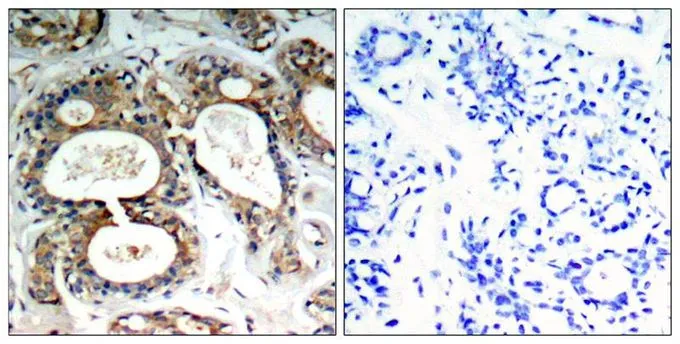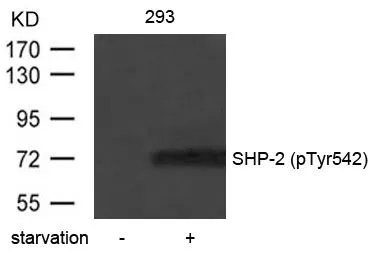
IHC-P analysis of human breast carcinoma tissue using GTX50328 SHP2 (phospho Tyr542) antibody. Left : Primary antibody Right : Primary antibody pre-incubated with the antigen specific peptide
SHP2 (phospho Tyr542) antibody
GTX50328
ApplicationsWestern Blot, ImmunoHistoChemistry, ImmunoHistoChemistry Paraffin
Product group Antibodies
ReactivityHuman
TargetPTPN11
Overview
- SupplierGeneTex
- Product NameSHP2 (phospho Tyr542) antibody
- Delivery Days Customer9
- Application Supplier NoteWB: 1:500-1:1000. IHC-P: 1:50-1:100. *Optimal dilutions/concentrations should be determined by the researcher.Not tested in other applications.
- ApplicationsWestern Blot, ImmunoHistoChemistry, ImmunoHistoChemistry Paraffin
- CertificationResearch Use Only
- ClonalityPolyclonal
- Concentration1 mg/ml
- ConjugateUnconjugated
- Gene ID5781
- Target namePTPN11
- Target descriptionprotein tyrosine phosphatase non-receptor type 11
- Target synonymsBPTP3; CFC; JMML; METCDS; NS1; protein-tyrosine phosphatase 1D; protein-tyrosine phosphatase 2C; PTP-1D; PTP2C; SH2 domain-containing protein tyrosine phosphatase 2; SHP2; SH-PTP2; SH-PTP3; tyrosine-protein phosphatase non-receptor type 11
- HostRabbit
- IsotypeIgG
- Protein IDQ06124
- Protein NameTyrosine-protein phosphatase non-receptor type 11
- Scientific DescriptionThe protein encoded by this gene is a member of the protein tyrosine phosphatase (PTP) family. PTPs are known to be signaling molecules that regulate a variety of cellular processes including cell growth, differentiation, mitotic cycle, and oncogenic transformation. This PTP contains two tandem Src homology-2 domains, which function as phospho-tyrosine binding domains and mediate the interaction of this PTP with its substrates. This PTP is widely expressed in most tissues and plays a regulatory role in various cell signaling events that are important for a diversity of cell functions, such as mitogenic activation, metabolic control, transcription regulation, and cell migration. Mutations in this gene are a cause of Noonan syndrome as well as acute myeloid leukemia. [provided by RefSeq, Aug 2016]
- ReactivityHuman
- Storage Instruction-20°C or -80°C,2°C to 8°C
- UNSPSC12352203

